Kebab
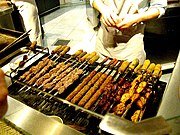
Left to right: Chenjeh Kabab, Kabab Koobideh, Jujeh Kabab in an Afghan restaurant.
Kebab (also transliterated as kabab, kabob, kibob, kebhav, kephav) refers to a variety of meat dishes in Middle Eastern, Mediterranean, African, Central Asian, and South Asian cuisines, consisting of grilled or broiled meats on a skewer or stick. The most common kebabs include lamb and beef, although others use goat, chicken, fish, or shellfish. Observant Muslims and Jews do not use pork for kebabs because of religious and cultural prohibition, but pork kebabs can be found in India, especially in the state of Goa. Like other ethnic foods brought by immigrants and travelers, the kebab has become part of everyday cuisine in multicultural countries such as the UK, Australia, New Zealand and the United States.
Etymology

Beef kebabs, before they are grilled
The word kabab (کباب) is ultimately from Persian[1][2] but originally meant fried meat, not grilled meat.[3] The Arabic word possibly derives from Aramaic כבבא kabbābā, which probably has its origins in Akkadian kabābu meaning "to burn, char".[4] In the 14th century, kebab is defined to be synonymous with tabahajah, a Persian word for a dish of fried meat pieces. The Persian word was considered more high-toned in the medieval period, and as a result, kebab was used infrequently in Arabic books of that time. Only in the Turkish period, shish kebab, did kebab gain its current meaning, whereas earlier shiwa` شواء had been the Arabic word for grilled meat. However, kebab still retains its original meaning in the names for stew-like dishes such as tas kebab (bowl kebab).[3] Similarly, "kebab halla" is an Egyptian dish of stewed beef and onions.
Shish kebab

Shish kebab (lamb, tomato, bell pepper, onion)
Shish kebab (Turkish: şiş kebap) is a dish consisting of small cubes of meat threaded on a skewer (şiş in Turkish) that are grilled or roasted. Any kind of meat may be used, and fruit or vegetables are often placed on the skewer as well. Typical vegetables include eggplant, tomato, bell pepper, onions, pickles and mushrooms. Small slices of toasted bread (usually sourdough, but other breads can be used as well) are also sometimes put onto the kebab stick with the meats and vegetables. The phrase literally means 'skewered grilled-meat' in Turkish.[5] In Greece and Cyprus, essentially the same dish is called "souvlaki" and in Serbia vesalica "raznjici".
In most dialects of North American English, the word kebab usually refers to shish kebab.[6][3] The origin of shish kebab may lie in the short supply of cooking fuel in the Near East, which made the cooking of large foods difficult, while urban economies made it easy to obtain small cuts of meat at a butcher's shop.[3] Although the phrase is essentially Turkish in origin and Turkish tradition has it that the dish was invented by medieval Turkic soldiers who used their swords to grill meat over open-field fires[7], the dish, however, has been native to the Near East and East Mediterranean -especially in Greece- since ancient times.[3] Indeed, there exist pictures of Byzantine Greeks preparing shish kebabs and such food is attested in Ancient Greece as early as 8th century BCE (archaic period) in Homer's Iliad [8] and Odyssey[7] and in classical Greece, amongst others in the works of Aristophanes[9], Xenophon[10] and Aristotle [11].
Ibn Battuta records that shish kebab was served in the royal houses of India since at least the Sultanate period, and even commoners would enjoy it for breakfast with naan.[12]
In Andalusia, a variant of the shish kebab, known as Pinchos Morunos or Moorish sticks, is very popular, usually eaten during summer barbecues. These are usually made of pork or chicken meat. In the town of Melilla, beef meat is generally used.
Recently, shish kebabs have been making their way into American barbecue. In Louisiana, for example, brochette, the French version of shish kebab, is also cooked at the barbecue because the barbecue style of the state is influenced by Cajun cuisine, which in turn was influenced by French cuisine, a major branch of Mediterranean cuisine.
Döner kebab
Döner kebab, literally "rotating meat" in Turkish, is sliced lamb or chicken loaf which is slowly roasted on a vertical rotating spit. It is similar to gyros and shawarma. Döner kebab is most popularly served in pita bread, as it is best known, with salad, but is also served in a dish with a salad and bread or French fries on the side, or used for Turkish pizzas called pide or "kebabpizza". Take-out döner kebab or shawarma restaurants are common in some parts of Europe. Döner kebab is said to be the best-selling fast food in Germany, Poland and Romania as well as being popular in Austria, the UK, France, Spain, The Netherlands, Belgium, Norway, Denmark, Sweden, Finland, Italy, Canada, Ireland, New Zealand and Australia.
In Australia and the UK, kebabs (or Döner meat and chips) are most popularly eaten after a night out, representing a large part of clubbing/pubbing culture. As a result, many kebab shops (and vans) will do their main business in the hours around closing time for local pubs and clubs (usually from 10pm to 4am). [13]The same applies for The Netherlands, Ireland, New Zealand, Canada and Scandinavia. It is therefore not uncommon to find similar late-night kebab vending shops in holiday-clubbing destinations such as Ibiza.
Chelow kabab
Chelow kabab (Persian: چلوکباب) is a national dish of Iran. The meal is simple, consisting of steamed, saffroned basmati or Persian rice (chelow) and kabab, of which there are several distinct Persian varieties. This dish is served everywhere throughout Iran today, but traditionally was most closely associated with the northern part of the country.
It is served with the basic Iranian meal accompaniments, in addition to grilled tomatoes on the side of the rice, and butter on top of the rice. It is an old northern tradition (probably originating in Tehran) that a raw egg yolk should be placed on top of the rice as well, though this is strictly optional, and most restaurants will not serve the rice this way unless it is specifically requested. Somagh (powdered sumac) is also made available, and if desired, only a dash should be sprinkled upon the rice.
In the old bazaar tradition, the rice (which is covered with a tin lid) and accompaniments are served first, immediately followed by the kababs, which are brought to the table by the waiter, who holds several skewers in his left hand, and a piece of flat bread (typically nan-e lavash) in his right. A skewer is placed directly on the rice and while holding the kabab down on the rice with the bread, the skewer is quickly pulled out. With the two most common kababs, barg and koobideh, two skewers are always served. In general, bazaar kabab restaurants only serve these two varieties, though there are exceptions.
The traditional beverage of choice to accompany chelow kabab is doogh, a Persian sour yogurt drink, flavored with salt and mint, and sometimes made with carbonated mineral water.
Kathi kebab
Cooked in a tandoor, Kathi kebab is one of the most famous tandoori dishes, besides tandoori chicken, which has made tandoori cuisine famous worldwide. Made with beef, chicken or lamb meat, it is mostly prepared with a mix of spices, and cooked in a tandoor with skewers. The radiant heat from the tandoor slowly cooks the meat and due to the lack of direct heat from the fire, the juices remain inside while adding flavour, keeping the meat's moisture intact. It is usually served with rice, or a variety of Indian breads, along with onions and mint sauce.

 Chicken
Chicken  3 Onions, finely chopped
3 Onions, finely chopped  8 pieces of chicken breasts (boneless)
8 pieces of chicken breasts (boneless)  8 Small flowerets of ½ inch size cauliflower
8 Small flowerets of ½ inch size cauliflower 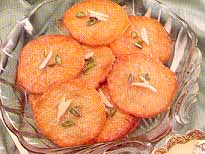
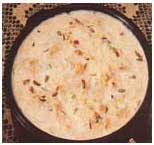




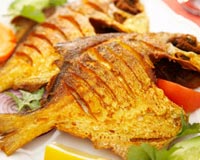


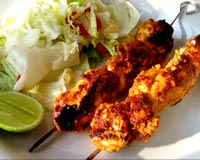
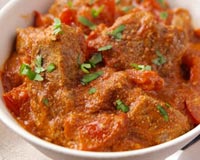
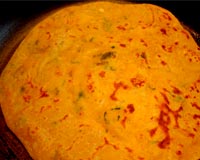
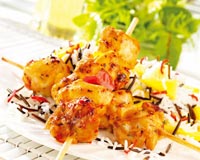
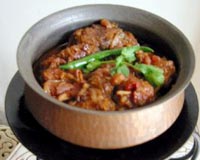









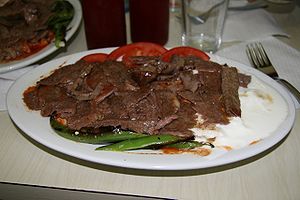

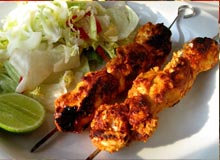 Mughlai cuisine is one of the most popular cuisines, whose origin can be traced back to the times of Mughal Empire. Mughlai cuisine consists of the dishes that were prepared in the kitchens of the royal Mughal Emperors. Indian cuisine is predominantly influenced by the cooking style practiced during the Mughal era. Mughlai food is quite spicy and has a very unique aroma. On eating Mughlai food, one can get a feel of the ground spices. The spices used in the preparation of Mughlai food are easily accessible.
Mughlai cuisine is one of the most popular cuisines, whose origin can be traced back to the times of Mughal Empire. Mughlai cuisine consists of the dishes that were prepared in the kitchens of the royal Mughal Emperors. Indian cuisine is predominantly influenced by the cooking style practiced during the Mughal era. Mughlai food is quite spicy and has a very unique aroma. On eating Mughlai food, one can get a feel of the ground spices. The spices used in the preparation of Mughlai food are easily accessible.